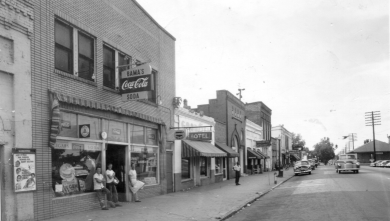At this time, Jonesboro contained within its corporate limits two churches, the Baptist and the Methodist; Philadelphia Presbyterian Church had been erected several miles north of Jonesboro in 1825, and served the town as well as the countryside. Members of other denominations attended services in Atlanta, which in 1869, was twenty miles away.
Because of the railroad, Jonesboro was a commercial center serving Fayette and Henry Counties as well as Clayton. On market days, its streets and loading docks were the scene of much activity, and during autumn, countless bales of cotton lined the railroad near the depot waiting shipment to other points. Aside from its prosperous business activity, Jonesboro in 1860 boasted several private residences which were large and imposing. Surrounding the town were the farms and plantations which formed the backbone of local economy.
When the War Between the States began in 1861, Clayton County met the severe demands of the times. Local cavalry and infantry units were organized, and citizen-soldiers drilled for war behind the courthouse in Jonesboro, before departing for Virginia battlefields. In 1864, the war was brought home. Throughout the spring and summer of that year, bitter battles were fought in a line from Chattanooga to Atlanta. The climax, after months of righting, thousands of deaths and untold destruction of property, was reached during the two days of August 31st and September 1st, 1864.
The Battle of Jonesboro was the most crucial engagement of the Georgia Campaign, and therefore, one of the most important battles of the entire war, for it directly resulted in the fall of Atlanta. Atlanta had become the Confederacy’s most important center of munitions and war supplies, and its capture was the objective of the campaign. Primarily through a tragedy of errors on the part of the Confederate high command, the Battle of Jonesboro was lost, and as its final shots were being exchanged, Atlanta was evacuated.
After the war’s end in 1865, Jonesboro began the task of rebuilding. The court house, depot, and other buildings had been destroyed during the war, and the town bore many scars of battle. The so-called “Reconstruction Era” did much to hinder local progress, and the decade following the war was marked by much turmoil and confusion. Nevertheless, Jonesboro emerged from the war with indications of returning prosperity, and the decade of the 1880’s saw this realized in an increasingly stabilized business and agricultural economy.
The importance of education had always been recognized by Jonesboro’s citizens, and from the time of the first local academy in 1823, Jonesboro had always made provisions for the schooling of its youth. During the war, the progress of civilization had been severely disrupted, but immediately after the war, classes at the academy were resumed. Soon it became apparent that educational opportunities should be expanded in Jonesboro. In 1880, a group of the town’s leading citizens organized as trustees, and founded Middle Georgia College. The institution played a vital role in the community for nearly thirty years, and from it emerged Jonesboro High School. Middle Georgia College was a private school, teaching young people of all ages. The Collegiate Division was similar to the junior colleges of today and placed great emphasis upon proper conduct and gentle manners as well as upon scholastic excellence. Pupils in the Collegiate Division were drawn not only from Jonesboro, but from other communities across the state as well. After the turn of the present century, an effort was made to establish the Middle Georgia Military Academy as a branch of the college, but after a few years, this was given up.
By the second decade of the present century, Jonesboro had begun to suffer a decline similar to that experienced by nearly all the smaller towns surrounding Atlanta. The improvement of transportation facilities, popularity of the automobile, and the loss of young people to larger cities combined to take a great toll on the town and its development. Then came the depression of the 1920’s and this had as devastating an effect upon Jonesboro as upon Georgia and the South. Recent years have brought a new prosperity, and Jonesboro is now distinguished by a strong spirit of new growth.
Jonesboro received international attention in 1936, with the publication of Margaret Mitchell’s novel, Gone with The Wind. Numerous scenes of this book were set in Clayton County. The characters and their homes were products of the author’s imagination, and only their inspirational prototypes may be found in the county today.


